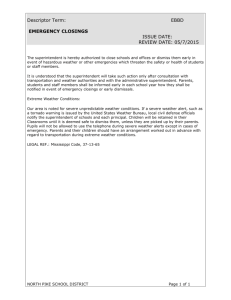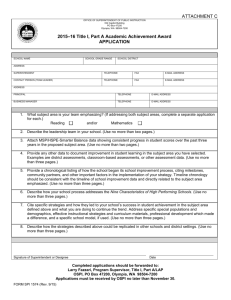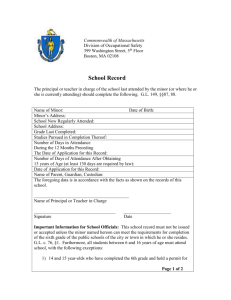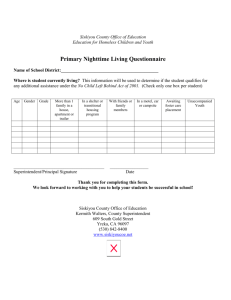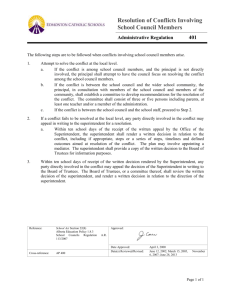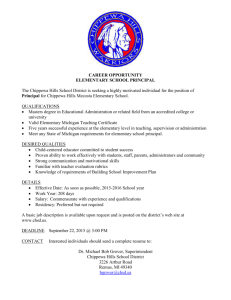My School District
advertisement
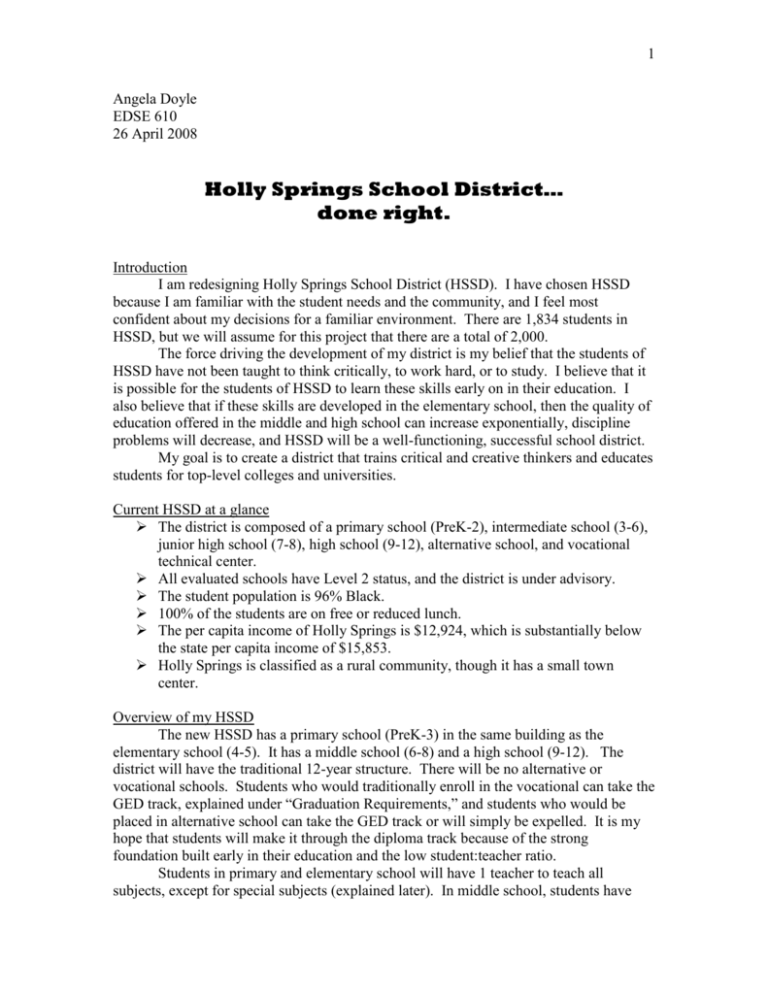
1 Angela Doyle EDSE 610 26 April 2008 Holly Springs School District… done right. Introduction I am redesigning Holly Springs School District (HSSD). I have chosen HSSD because I am familiar with the student needs and the community, and I feel most confident about my decisions for a familiar environment. There are 1,834 students in HSSD, but we will assume for this project that there are a total of 2,000. The force driving the development of my district is my belief that the students of HSSD have not been taught to think critically, to work hard, or to study. I believe that it is possible for the students of HSSD to learn these skills early on in their education. I also believe that if these skills are developed in the elementary school, then the quality of education offered in the middle and high school can increase exponentially, discipline problems will decrease, and HSSD will be a well-functioning, successful school district. My goal is to create a district that trains critical and creative thinkers and educates students for top-level colleges and universities. Current HSSD at a glance The district is composed of a primary school (PreK-2), intermediate school (3-6), junior high school (7-8), high school (9-12), alternative school, and vocational technical center. All evaluated schools have Level 2 status, and the district is under advisory. The student population is 96% Black. 100% of the students are on free or reduced lunch. The per capita income of Holly Springs is $12,924, which is substantially below the state per capita income of $15,853. Holly Springs is classified as a rural community, though it has a small town center. Overview of my HSSD The new HSSD has a primary school (PreK-3) in the same building as the elementary school (4-5). It has a middle school (6-8) and a high school (9-12). The district will have the traditional 12-year structure. There will be no alternative or vocational schools. Students who would traditionally enroll in the vocational can take the GED track, explained under “Graduation Requirements,” and students who would be placed in alternative school can take the GED track or will simply be expelled. It is my hope that students will make it through the diploma track because of the strong foundation built early in their education and the low student:teacher ratio. Students in primary and elementary school will have 1 teacher to teach all subjects, except for special subjects (explained later). In middle school, students have 2 two main teachers: one for math/science and another for English/history. Students change all classes and teachers in high school. Here is my anticipated student population breakdown: Grade PreK Kindergarten 1 2 3 4 5 # of Students 120 160 160 160 160 160 160 Grade 6 7 8 9 10 11 12 # of students 160 160 160 140 110 100 90 Buildings All buildings will be either one long hall or one big square. This way, all classrooms will have at least two windows. See below: Governance Essentially, the Superintendent is the dictator of my district. Powers are dispersed at her discretion. I realize that this governance structure has a huge potential for corruption, but I trust that a Superintendent will have the best interests of the district in mind, that a 4-year term would limit any severe damages, and that concentrating power will increase the possibility for change and improvement. My new inventions to governance are what I call, blandly, Team and Advisory Committee. The Team is a group of 4 teachers and 4 administrators from the district who appoint the Superintendent, have influence over hiring, firing, merit pay, contract renewal, expulsions, and other powers traditionally reserved for the school board. The Team serves 4-year terms. Instead of a School Board, HSSD will have an Advisory Committee from the community and voted on by the community. The Advisory Committee will appoint the administrators and teachers onto the Team. The Advisory Committee will serve other, well, advisory functions but will not have many actual powers. They can deliver 3 opinions and have minor powers. The members of the Advisory committee will serve 3year terms, staggered with two people being elected every year. The appointed Superintendent (hopefully me) will serve a 4-year term, staggered with the Team’s 4-year term. There is no limit to the number of terms one Superintendent can serve. The Team has the power to vote the Superintendent out of office only upon discovery of some crime or breach of contract or if the vote is unanimous and the Advisory Committee agrees with the unanimous vote. The Superintendent will hold all major powers in the district—school policies, student handbooks, etc. Any powers and responsibilities of the principals will be delegated and delineated by the Superintendent. I expect that the Superintendent will delegate many powers to the Principals, but I think it is best to leave the choice of specific powers to the Superintendent. The Superintendent will hire principals. Principals will hire other administrators with the Superintendent reserving the veto power. Administrative structure will be as follows: The Primary School will have a Principal and a Vice Principal. The Elementary School will have a Principal. The Middle School will have a Principal and 3 deans. The High School will have a Principal and 4 deans. Governance in schools and Discipline Just as the Superintendent is the Dictator of the district, the Principal is the dictator of any given school, yielding only to the Superintendent. S/he can delegate power and responsibility as s/he sees fit. The Principal also sets rules for her/his school and must obey the set of district rules. The Superintendent has the power to change the rules in any given school, and administrators must obey the rules as she dictates. Teachers in HSSD will have considerable power in matters of discipline. They can sentence students to detentions after school (a late bus will run) or ISS during the day. They will report any disciplinary measures to the deans in the form of discipline reports, though deans will also receive lists of students sent to ISS and detention and by which teachers. Teachers may also simply fill out behavior referrals to the dean if they are requesting out of school suspensions or reporting a serious class disruption. Deans will handle discipline problems by lecturing students, contacting parents, and assigning students to out-of-school detentions. Deans will also drop in to difficult periods for teachers and aid in the general behavior management of the school. A completely new addition to HSSD will be Co-Teachers. Co-Teachers are informal discipline experts. Co-Teachers are not necessarily trained in education but can score at least a 24 on the ACT (a practice exam will be administered if no formal reports are available). They will be chosen based on a strict personality and general ability to function as classroom assistants. One Co-Teacher will be assigned to 3 teachers to aid them throughout the day. Co-Teachers will also float the halls and perform cafeteria and morning duty. The best Co-Teachers will be mothers from the community with a special adaptability to different teaching styles. Co-Teachers will both formally and informally handle discipline problems in the school. They can take students directly to ISS if they catch them in the halls without a pass, but they cannot sentence students to detention. Co-Teachers may also write formal behavior referrals for the deans or for the teachers. 4 Expulsion policies will be changed so that students will be expelled after 6 behavior referrals and/or days in ISS. No students will be allowed into class tardy. In fact, students arriving to class after the late bell will be escorted directly to ISS by a CoTeacher. To help students with the new tardy policy, a warning bell will sound 1 minute before the actual bell for class. All students must be in class by the class bell. Daily Schedules The Primary and Elementary schools will be in session from 7:30 - 3:30. Students will stay with one teacher except for designated gym, elective, and lunch times. There will not be formal “periods” for the day—merely designated times for each activity. The Middle school will be in session from 8-4 with official block periods. There will be 4 periods a day: one for science/math; one for social studies/English; one for elective/Project; one for gym/health/remediate/elective. The High school will be in session from 9-4 with 4 block periods. The 4th period in high school is reserved for tutoring, activities, gym, and Project, as will be explained later. The annual calendar for all schools will remain standard. I see no reason to change this—it makes sense to be on the same schedule as every other district. Community Involvement Much community involvement will occur naturally because Co-Teachers, support staff, and the Advisory Committee will be from the community. My more novel ideas include: Parent-Teacher-Administrator Social sponsored by local businesses. Students will have the incentive of out-of-uniform days if their parents attend. “Mama Cooks Best Competition.” The cafeteria staff will compile a list of available ingredients in the cafeteria kitchen. Grandparents and parents can submit lunch recipes using those ingredients. Chosen recipes will be cooked under the parent or community member’s tutelage for the students. Winners will receive handshakes from the students and recognition by local papers, the school billboard, and the school newsletter. Project. The senior Project required for graduation will be a community improvement project created and executed by a senior. All other Projects over the 4-12th years will require input from the community throughout the student’s research. “Back to School Night” for parents of students in all grades in September and January during which parents experience a mini-day at night in the life of their child—spending time with their teachers, changing classes, sitting in their desks, etc. “Bring a Parent to School Day” in Primary and Elementary school when parents come to school with their child for the day. It occurs during the first semester. “Drop-in Day” for Middle and High School when parents are encouraged to drop-in on their students. It occurs during the first semester. Career Days in Elementary and Middle schools when parents and professionals can come speak to the classes about their jobs 5 College Days. HSSD graduates who are attending or have graduated from a top-tier college or university will be invited back to speak to Middle school students. Teacher Relief. Parent volunteers will sign up for a day to relieve a teacher— not costing the teacher a personal or sick day. The parent will be the acting substitute in that teacher’s classes, gaining respect for the teacher’s job and insight into school problems and policies. Sports Games and Performances. Teachers will be paid for going to sports games and school performances. They must clock in and out with portable finger-printer and will be paid by the hour. Report cards must be picked up and signed for by a parent every quarter. Parents who don’t pick up report cards will be contacted by the guidance counselors and informed of student progress. HSSD Newsletter. A newsletter about HSSD events and decisions will be published and distributed in the community. Students will create the newsletter during an activity period. HSSD Billboard. Announcements will be posted on a big, obnoxious HSSD billboard. Adult Tutoring. Night tutoring of parents by math and English teachers. Community businesses will pay for this program by taking out advertisements on the school newsletter and the school billboard. The products/services advertised must be approved by the Advisory Committee and the Team. Curriculum The priorities of the HSSD curriculum are critical thinking and independent study habits. The curriculum in all years will emphasize homework, projects, inference, and deduction. We will use the MDE curriculum, but all objectives will be covered at DOK 3 or 4. In the Primary and Elementary school, students will be tracked by attention span and focus. This way, students will longer attention spans can work on the same types of projects for the same amount of time. Students with shorter attention spans will be given appropriately timed activities, too. These classes will be taught in an exploratory fashion, though some things will be taught formally—like phonics and arithmetic. Nevertheless, every lesson will emphasize predictions, experimentation, cause and effect, and critical thinking. Open-ended assessments will be used. Two teachers will be hired as a reading specialist for the elementary school, in addition to the classroom teachers. These teachers will work with teachers to develop special reading lessons, and they will also work with struggling readers to tutor them up to grade level. Students must pass a basic reading test to advance past 3rd grade. The test will be aimed at 90% promotion for the typical 3rd grade bell curve, but as many will remain behind in 3rd grade as do not pass the test. The Middle school will start tracking students by ability. English and social studies will be taught together in a cross-curricular fashion. Likewise, math and science will be taught in the same period in a cross-curricular fashion. Students will be placed in levels 1, 2 or 3 of each subject based on their reading and writing abilities (for language 6 and social studies) and their math skills (for math and science). Open-ended assessments will be used. In High school, tracking by ability will continue. Each section of a given prep will have a level—i.e. Trigonometry (1), Trigonometry (2), etc. All of the high school curriculum will be MDS curriculum except for English. HSSD will use the following courses in its English sequence. Students will take an English placement exam during April of their 8th grade year: o English Composition—a heavy emphasis on grammar, usage, and basic reading comprehension o Literature—more of an emphasis on reading comprehension, critical thinking, and essay writing. o Advanced Literature—advanced reading comprehension, critical thinking, and paper-writing. o Introduction to Literary Analysis o Literary Analysis High school evaluation will be both open-ended and multiple-choice. Students need to prepare themselves for the ACT and MS subject area tests, so teachers should administer some multiple-choice tests to this end. I considered holistic, cross-curricular teaching in the High school, but I do not think that many teachers trained in high school level English, math, science, and social students are available. In fact, I do not think that any teachers are trained for the ability to teach all major high school subjects. In a perfect world… The delivery system for the curriculum in my district will be a web bank. Every grade and course will have an online site housing pacing guides, lesson plans, tests, and activities used by current and past teachers. Certain documents will remain unchanged except by the district curriculum coordinators—pacing guides, final exams, and general course curriculum—however each teacher may adapt lesson plans, unit tests, and other activities. The site for each course and grade will also contain resources and contacts for teachers. Electives/Activities The Middle School will have electives that students will rotate with their Projects period and their gym/health period. The choice of electives includes band, choir, newsletter, drama, and foreign language. In the High school, 4th block will be Activity/tutoring block (to also rotate with Projects and gym on a 4-day rotation). One teacher in every department will serve as that department’s tutor instead of running an activity. All teachers not appointed as tutors, however, will run a student activity (or have their planning period if scheduling necessitates). The activities we will have include: newsletter, band, choir, chess club, debate club, world cultures club, math bowl, science Olympiad, nature club, and work crew. In the High School, seniors will have special class options since all of their graduation requirements may be complete. These non-instruction based electives include teacher’s aides, hall monitors, work crew, cafeteria crew. Seniors entering these electives 7 must have character approval by the Team and their roster of teachers. Also, these special electives are for diploma track students only. Project: My favorite part! Starting in 4th grade, all students will have a year-long Project to complete. The Project will integrate subject areas, student interests, technology, and community resources. Each year’s project will have a different theme, but every project will stress research, creation, and evaluation. Starting in Middle school, a special Projects teacher will run a Projects class. Successful completion of each project is required for promotion. Projects in grades 4 and 5 will be graded by the elementary teacher. The themes of each project will be as follows: Grade 4 5 6 7 8 9 10 11 12 Project Theme Science Fair Creative Writing History Analysis Intern/Volunteer Math—research or teach Sciecne Fair II ACT prep College Research and Application Community Improvement The Projects class in middle and high school will be a partial class. In Middle School it will alternate with the elective class, and in High school it will alternate with gym, elective, and activities during 4th period. Technology Technology will be utilized as follows: Curriculum will be organized and updated by course and grade websites. Teacher gradebooks will be kept online for accses by parents, students, and teachers. Attendence will be kept online to immediately catch skips. All classrooms will have a working computer with internet access and a working phone. A database of student’s parent’s telephone numbers will be available online. Teachers will be trained and encouraged to create course websites to post important dates and assignments. Teachers will also be taught how to create and use discussion boards in conjunction with coursework. Projects will involve technology—making websites, movies, podcasts, slideshows, etc. Teachers will sign in and out with a fingerprint scanner. 8 Graduation Requirements In Primary, Elementary, and Middle school students will not be promoted if they fail more than one subject or if they fail the Project. The Project must be successfully completed for promotion. In High school, there are two tracks for graduation—the GED track and the Diploma track. Students will decide their freshman year with the help of their Guidance Counselor which track they will take. Students on the GED track will take GED classes first and second period until they pass the GED. This track is essentially a work-study, and these students must leave campus after 2nd period to go work jobs. These students are not held responsible for the Project. The Diploma track in high school requires 28 class credits, the successful completion of all 4 high school Projects, and passing all state subject area tests. Students will take a total of 32 classes (counting classes which rotate—activities and projects— as fractions of classes all adding up to 8 classes in any given year) and must pass 28 of them in order to graduate. Of those 28, 4 must be in math, 4 must be in social students, 4 must be in science, and 4 must be in English. Block scheduling will allow students to double up on a subject in a year if they fail a core class. Except for students on the GED track in high school, all students in every school will take a class during every block of the school day. The grading scale will be out of 100, but the letter evaluation will be more lenient—a 60 will be the cutoff for passing grades. Here is the new grading scale: Point Value 90-100 80-89 70-79 60-69 0-59 Letter Grade A B C D F Teachers and Staff The following charts show my anticipated number of teachers and other faculty for each school. Grade PreK K 1 2 3 4 5 6 7 Student Population 120 160 160 160 160 160 160 160 160 # of Teachers 10 14 12 12 12 11 11 11 11 # of CoTeachers 0 0 3 3 3 3 3 3 3 Student::Teacher 12:1 11.4:1 10.7:1 10.7:1 10.7:1 11.4:1 11.4:1 11.4:1 11.4:1 9 8 9 10 11 12 160 140 110 100 90 School Primary Elementary Middle High School District 11 40 Total for the High, Alternative, and Vocational Schools 155 Type of Adminstrator or other Faculty Principal Vice Principal Social Worker Lead Teacher Principal School Counselor Lead Teacher Reading Specialists Principal Dean Guidance Counselor Lead Teacher Principal Dean Guidance Counselor Lead Teacher Technology Personnel Curriculum Coordinator Superintendent Assistant Superintendent TOTAL School Primary/Elementary Middle Type of Support Staff Secretary Janitor Cafeteria workers Librarian Secretary Janitor 3 11.4:1 10 Total for 11:1 the High School 34 Number Salary 1 1 3 3 1 1 2 2 1 3 4 3 1 4 4 4 3 5 110,000 60,000 40,000 85,000 110,000 40,000 85,000 90,000 110,000 50,000 50,000 85,000 110,000 50,000 50,000 85,000 80,000 70,000 1 1 110,000 80,000 46 3,990,000 Number Salary 2 4 6 1 2 3 45,000 40,000 20,000 30,000 45,000 40,000 10 High School District Cafeteria workers Librarian ISS attendant Secretary Janitor Cafeteria workers Librarian ISS attendant Secretary Payroll TOTAL 4 1 1 2 4 6 2 2 2 2 44 20,000 50,000 30,000 45,000 40,000 20,000 50,000 30,000 45,000 40,000 1,450,000 Teachers will be paid a base salary of $50,000 for up to 4 years of experience. For 5-9 years of experience, teachers will be paid a base salary of 60,000. Teacher with 10+ years of experience will be paid 70,000. Co-Teachers will be paid 40,000 flat. Additional merit and special duties pay will be awarded to members of the faculty and staff. These are explained under “Other Budget Items.” Summary of Payroll Costs Staff Teachers (155 x 60K) Co-Teachers (34 x 40K) Administrators and other Faculty Support Staff SUBTOTAL x 1.25 for benefits and taxes TOTAL Cost 9,300,000 1,360,000 3,990,000 1,450,000 16,100,000 20,125,000 Hiring, Firing, and Evaluation Teachers will be hired by the Principal of each school, but they must be approved by the Team before being hired. Likewise, teachers will be fired by the Principal or the Superintendent after consultation with the Team. The two factors in contract renewal decisions will be whether the teacher fulfilled his duties and how he performed on his evaluations. Teacher evaluations will be done by drop-ins, drop-ins, and more drop-ins! The Lead teachers will function as teaching quality control agents. They will do announced and unannounced drop-ins on the teachers very frequently—at least 4 times in a 9-weeks for every teacher. The Lead teacher will give almost immediate formal and informal feedback to the teachers, stressing critical thinking, DOK 3 and 4 activities, and independent study habits. Teaching in HSSD must stress exploration, critical thinking, and creativity. Evaluations will address any teacher shortcoming in this area and, hopefully, will weed out teachers who are not teaching in an appropriate manner for HSSD’s vision. 11 Other Budget Items The final $9.875 million in the HSSD account will be used to support the following programs: Merit Pay. All Principals will have 8,000 per teacher/co-teacher to distribute however they feel appropriate as merit pay for faculty and staff members. Teacher evaluations will be the main factor in determining merit pay. (1,512,000) $5,000 bonus to all Team members (40,000) $3,000 to all state tested subject teachers (21,000) $5,000 bonus to all high school department chairs (20,000) $5,000 bonus to all coaches (40,000) Classroom Funds, books, and School Supplies (3,000,000) Scholarships, college visits, and other college-preparatory programs (1,000,000) Sports Budget (1,000,000) Music Budget (2,000,000) Other Activities Budget (342,000)
